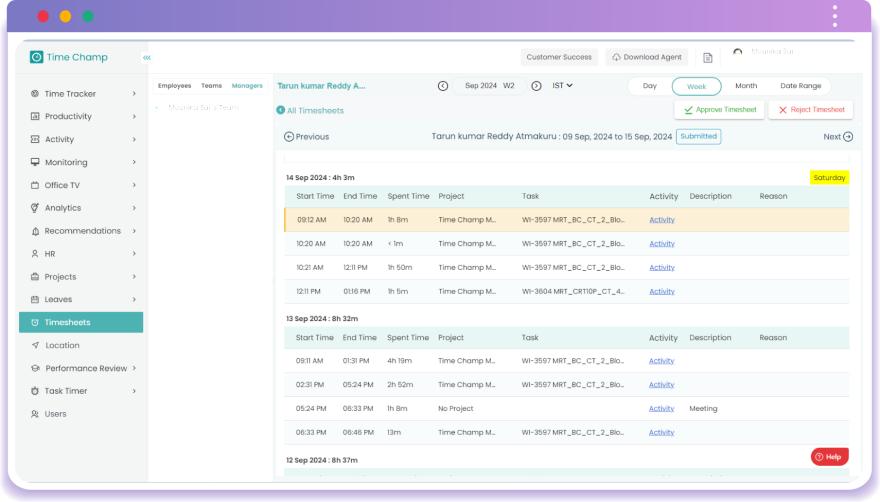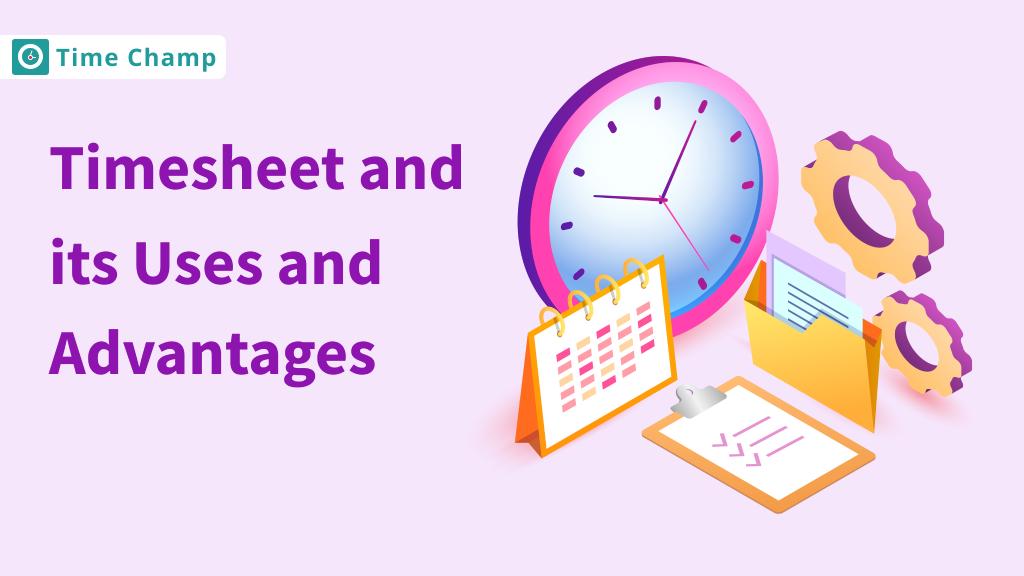Are you in search of a solution to make tracking time in your team easier? It is where Timesheet templates come in handy. They assist in time management and planning, but since there are different kinds of timesheet templates, one must select the correct one.
In this blog, you will learn about the various types of timesheet templates, what to consider, and their drawbacks. Delve into how the right timesheet template can help you manage your time better and increase your productivity.
What is a Timesheet Template?
A timesheet template is a format that is already designed and can be employed to log the working hours, activities of a team. It is like a simple time card that enables the employees to indicate the time they have spent on a given task, and employers or managers to identify who is doing what and how long he or she has taken. It can be very useful in maintaining payroll, assessing the work progress, and identifying areas where time might be slipping away from the team. The right timesheet template will assist your team to work smart and be in a position to manage their time well.
What to Look for in a Timesheet Template?
Follow are the things you need to look for when considering a timesheet template.
1. Ease of Use:
The template should be easy for your team to use so that they can be able to log their hours without any hitches. This will save time for everyone and reduce errors because the format is well laid down. A well-organized template also saves time to introduce your team to the usage of the template as everyone can start using it immediately.
2. Customizability:
The template should be flexible enough to meet your needs. A template that can be easily expanded with fields for different tasks or with custom time intervals will be suitable for your team and any shifts in projects or processes.
3. Accuracy:
Ensure that the template will allow for accurate time tracking. This includes the fields for begin and end times, breaks and total hours. Payroll, client billing, and productivity reports are crucial for the operations of the company, and therefore, data should be accurate. It will also reduce the chances of confusion and costly mistakes by avoiding similarities in the elements.
4. Compliance Features:
When selecting the best timesheet template, make sure it includes characteristics such as the ability to log work time, break time, working overtime, and any time off that your team may take. This will help you to ensure that you do not encounter any legal issues and that all the processes are recorded in a manner that you are not breaching the law.
5. Integration with Existing Systems:
Choose a timesheet template that will be easily integrated into your current system for instance your time management tool or your payroll system. This means that the template needs to be compatible with the tools you are already using, and this will assist in the transfer of data without much strain. Integration is important in order to avoid time wastage and to reduce the chances of an error which is important in ensuring that everything runs as planned.
Types of Timesheet Templates:
Let’s see the different types of timesheet templates.
Daily Timesheet Template:

A daily timesheet template is one of the most important documents that a manager should use to track the daily activities of his or her team. It helps one to manage working hours effectively and also makes it possible to account for all the time spent on a particular activity. This template is particularly useful for organizations that are engaged in several projects at once since it offers a structure for time tracking. When you employ a daily timesheet template, you can make the right decision on how to allocate the resources, determine the payroll correctly, and enhance the accountability of the team, which will boost productivity.
Things to Include in a Daily Timesheet Template:
- Employee information: Begin with simple information such as the employee’s name, identification number, and department. This assists in determining who is completing the timesheet.
- Date: Make sure that there is enough space for the date so that each entry is properly made for the particular day.
- Start and End Times: Provide fields for the time that an employee begins and the time he or she ends work. This will enable you to know the number of hours he or she has worked in a day.
- Break times: Ensure that there is a field for recording breaks as this affects the overall working hours and compliance with labor laws.
- Tasks or projects: Ensure that there is an area where the employee can write the particular activities or the projects that he or she accomplished in the course of the day. This assists in determining how time is being spent on various tasks.
- Total hours worked: Add a field that will calculate the total number of hours that the employee has worked and this field should be one that is easily understandable by both you and your employees.
- Approval signature: Last but not least, there should be a section where the employee and the manager or the supervisor should acknowledge the fact that they have gone through the timesheet and have approved it.
Use Cases of the Daily Timesheet Template:
-
Employee Time Tracking
-
Project Management
-
Client Billing
-
Compliance and Reporting
-
Performance Evaluation
-
Budgeting and Cost Management
Weekly Timesheet Template:

A weekly timesheet template is useful in tracking your team’s performance and time utilization within a week. It records daily working time, including the start and end time, which gives a clear picture of the total working hours and overtime. By logging activities, you get to know how much time you spend on a particular task, which helps in managing resources and scheduling projects. This template makes the process of calculating the employees’ wages easier, helps to adhere to the legal requirements, and increases the level of responsibility among the team members due to detailed time management.
Things to Include in a Weekly Timesheet Template:
Employee Details:
This will include simple data such as the employee’s name, department, and position. This helps to make sure that each timesheet is associated with the right individual.
- Dates covered: Every weekly timesheet template will contain the dates that are covered by the particular timesheet, which are usually from Monday to Friday (or including Saturday and Sunday). This assists you in ensuring that the precise period being documented is well understood.
- Daily start and end times: For each day of the week, the template will record the time an employee begins working and the time he or she leaves work. This enables you to track their working hours in a day effectively.
- Total hours worked: The template helps you calculate the total hours worked per day, both the normal working hours and the overtime hours. This provides you with a clear picture of the amount of time that your team is dedicating.
- Breaks taken: It is also necessary to document any breaks that are taken during the day. This assists in compliance with labour laws, supports adherence to break time policies, and provides a comprehensive view of the working day.
- Task or project details: If your team is involved in different projects, the template can have fields where the employee can record the time spent on a particular task or project. This is useful for resource management and project tracking.
- Signatures: It is common to have a space for both the employee’s and the manager’s signatures at the end of the document. This provides an extra layer of assurance and ensures that the recorded hours are genuine.
- Notes or comments: At times, there may be a need to include extra annotations or remarks. This section is useful for the employee or the manager to give additional details, for instance, the cause of working extra hours or any deviation from the normal working schedule.
Use Cases of the Weekly Timesheet Template:
-
Weekly Payroll Processing
-
Project Tracking and Management
-
Time-off and Leave Management
-
Budgeting and Cost Tracking
-
Performance Analysis and Reporting
Biweekly Timesheet Template:

A biweekly timesheet template is a useful tool that allows you to record your team’s working hours for two weeks at a time, which is beneficial when it comes to payroll and project expenses. It is easy to identify who is working when and for how long, which helps in the right distribution of resources. This template also makes it easier to approve work hours, overtime, and any time off since everything is presented in a clear manner. It is a simple tool that helps in the accuracy of the payroll and also improves the general management of time.
Things to Include in a Biweekly Timesheet Template:
- Employee information: Some of the information you will need to provide includes the employee’s name, department, and position. This assists in determining who the timesheet belongs to, which makes it easier for you to sort and analyze the information.
- Work hours: It is important to record the time when the workday begins and when it ends. This way, you can track the time your team members spend on the tasks and make sure that everyone works the necessary amount of time.
- Overtime: Make sure to add a section for any extra hours that were put in. This is important for calculating overtime pay and other related payments so that all the extra hours worked are well compensated.
- Time off: Include a section for any time off like vacation or sick leave. This assists you in tracking the number of employees who are away from work and guarantees that everyone’s time off is fairly handled.
- Approval section: You should also provide a section for approval. This makes it possible for you to approve the hours worked before the payroll is processed, thus reducing the chances of errors.
Use Cases of the Biweekly Timesheet Template:
-
Biweekly Payroll Processing
-
Tracking Employee Work Hours and Overtime
-
Managing Project Budgets and Costs
-
Reviewing Employee Productivity
-
Monitoring Attendance and Leave
-
Ensuring Compliance with Labor Regulations
Monthly Timesheet Template:

A monthly timesheet template is useful in tracking employee hours and tasks for the whole month. It usually contains columns for work descriptions, overtime, project numbers, and total hours. You will find the fields for the input of the employee details and approval signatures that help in the processing of payroll and project management. This template gives a clear picture of how time is spent, helping you assess productivity and determine the correct compensation. It makes tracking easier and keeps everything for monthly timesheet reports.
Things to Include in a Monthly Timesheet Template:
- Columns for work descriptions: In your monthly timesheet template, you should add columns where you describe the work done in detail. This assists you in monitoring what tasks are being done by the employees and also aids in making sure that there is no confusion when it comes to reporting.
- Overtime tracking: It is also important to ensure that there is a section where overtime hours are recorded. This enables you to track any overtime worked and control the pay accordingly to ensure that it is fair.
- Project numbers: Include columns for project numbers or codes. This makes it easy to associate the hours worked with the project, which is useful in monitoring the project costs and progress.
- Total hours: Make a section for the total hours worked. This gives you a summary of hours for each employee, which makes it easier to calculate payroll and make the right payments.
- Employee information: Must contain fields for the employee information such as the name and the identification number. This helps in ensuring that the timesheets are properly associated with the right employees and thus minimizes the common mistakes that are likely to occur when preparing the payrolls.
- Approval signatures: Make room for approval signatures. This step ensures that the recorded hours have been checked and signed off, which is important in the validation of the timesheet before the payroll is processed.
Use Cases of the Monthly Timesheet Template:
-
Monthly Payroll Calculations
-
Tracking Long-Term Project Progress
-
Analyzing Monthly Work Hours and Attendance
-
Budgeting and Financial Planning
-
Evaluating Employee Performance Trends
-
Managing Employee Leave and Absences
Project Timesheet Template:

A project timesheet template is used to monitor the time that is spent on different projects by your team. It has columns for project names, tasks, and hours logged, which enables you to determine where time is being spent. It is also possible to track project codes or numbers in relation to particular budgets and timeframes. This template assists you in tracking the progress of the project, controlling the resources, and billing or costing the project appropriately. It makes reporting easier and ensures that all the necessary documents are well arranged for easy project time management.
Things to Include in a Project Timesheet Template:
- Project names: Make sure to add columns for project names in your Project Timesheet Template. This assists in tracking which projects the hours are being recorded against especially when working on different projects at the same time.
- Task descriptions: Include a section for task descriptions. This lets you track what work is being done on each project, which is helpful for understanding how time is being spent and whether tasks are moving forward as expected.
- Hours worked: Ensure that you have fields for hours worked. This is useful in tracking the amount of time each team member spends on different activities, which can be useful in tracking productivity and workloads.
- Project codes: Include project codes or numbers in your template. This relates the hours worked to certain budgets and time frames, which assists in managing costs and guaranteeing that projects do not exceed their financial and temporal limits.
- Total hours: Include a row for total hours worked. This provides you with an overview of the hours for each project, which makes it easier to calculate the cost of each project and review the progress of the project.
- Employee Details: Add fields for the employee details such as the name and the identification number. This makes it possible to match the timesheets to the right team members, thus avoiding confusion and making it easier to process payroll.
- Approval signatures: Allow space for approval signatures. This affirms that the recorded hours have been checked and signed, making the timesheet authentic and valid before going to the next step.
Use Cases of the Project Timesheet Template:
-
Project Tracking
-
Project Budget Management
-
Resource Allocation
-
Client Billing
-
Performance Analysis
Drawbacks of Using Manual Time Tracking Templates:
Some of the limitations of using manual time tracking templates.
1. Time-Consuming Data Entry:
Manual time tracking templates imply that you and your team have to spend a lot of time inputting data by hand. This process can be time-consuming and boring, thus diverting your attention from other more important activities. It results in time wastage and poor utilization of your team’s efforts and resources in the process.
2. Increases the Risk of Errors:
Manual data entry is also likely to be associated with errors like wrong calculations or wrong entries. Such mistakes can result in wrong records and may cause a disturbance in the project budget and time frame. Rechecking each entry takes time and effort, and the probability of missing errors is higher.
3. Difficulty in Tracking Changes:
If you are using paper or simple electronic forms, it becomes difficult to track changes or updates. If someone needs to correct an entry, it is not easy to understand what was done and why it was done. This lack of visibility can cause problems such as confusion and the inability to track progress effectively.
4. Limits Reporting Capabilities:
Manual templates may not have the ability to generate reports with more complex features. It may be challenging to provide specific reports or analysis on how time is being spent on different projects. This hampers your capacity to track performance trends and make informed decisions for your team or organization.
5. Inefficient Data Storage:
It becomes cumbersome to store and manage physical or basic digital time tracking templates. It is sometimes difficult to locate a particular record or historical data, which results in time wastage when searching for information.
6. Lack of Integration:
Manual templates do not interface with other applications such as project management or payroll software. This means that you may have to export data from one system and import it into another, which is time-consuming and prone to errors.
Use Time Champ: A Streamlined Time Tracking and Timesheet Management Solution
Time Champ is a powerful time management tool that helps you manage your time tracking and timesheets . It helps you and your team record working hours and handle timesheets more efficiently. Time Champ is easy to use and it assists you in managing your time effectively without much effort. Here are the key features that make it a game-changer for you and your team.
1. Efficient Time Tracking:

Time Champ enables you to track your team’s time efficiently and effortlessly, making it easy to fit into your workflow. It makes it easy to record work hours, which means that you do not have to spend a lot of time inputting data. This straightforward software allows all users to record their hours correctly and in a timely manner.
2. Simplifies Timesheet Management:

With Time Champ, managing timesheets is as easy as pie. It also allows you to easily review, approve, and manage timesheets in one location. It accelerates the approval process and ensures that you have the most recent records at your disposal.
3. Accurate Reporting:
Time Champ has rich reporting capabilities that allow you to create comprehensive reports on how time is being spent on projects. This assists you in monitoring the performance trends, analyzing the strengths and weaknesses, and making the right decisions for your team.
4. Seamless Integration:
Time Champ can be easily integrated into your current systems and processes. Regardless of whether you are using it for your payroll or project management software, Time Champ makes data transfer seamless, thus minimizing the chances of making mistakes and saving time.
5. User-Friendly Experience:
The platform is easy to use and is developed with the user in mind. Your team will not spend a lot of time trying to understand how the software works, which saves time and increases efficiency.
6. Enhances Visibility:
It is easy to track changes and updates. Time Champ also offers the records of who made changes and the reasons for the changes, which is important in avoiding confusion.
Conclusion
Selecting the right timesheet template can go a long way in helping you and your team manage time and tasks effectively. Regardless of whether you require daily, weekly, biweekly, or monthly hours, each type of template has its advantages. Manual timesheets may be time-consuming and contain errors, but choosing the right template makes it easier and faster to track time, thus increasing the efficiency of your team.
Enhance your timesheet management with Time Champ
Try it now for effortless and accurate time tracking!
SignUp for FreeBook DemoFrequently Asked Questions
Time sheet templates help in recording working hours, planning and utilization of resources, payroll processing and meeting legal requirements. They also assist in project management and performance tracking.
Through recording the start and end time, breaks, and overtime, a timesheet template helps in avoiding payroll mistakes and ensuring that employees are paid fairly.
Timesheet templates help in recording the time spent on specific activities and projects so that the managers can plan and allocate resources well, monitor the progress of projects, and control the expenses.
Manual templates can cause mistakes, take time to complete, and are not easy to monitor for overtime or breaks. They also do not fit well with automated payroll systems and are more likely to contain errors.
Many time sheet templates can be synchronized with the payroll systems and project management tools, thus minimizing the possibility of making mistakes when transferring data.




